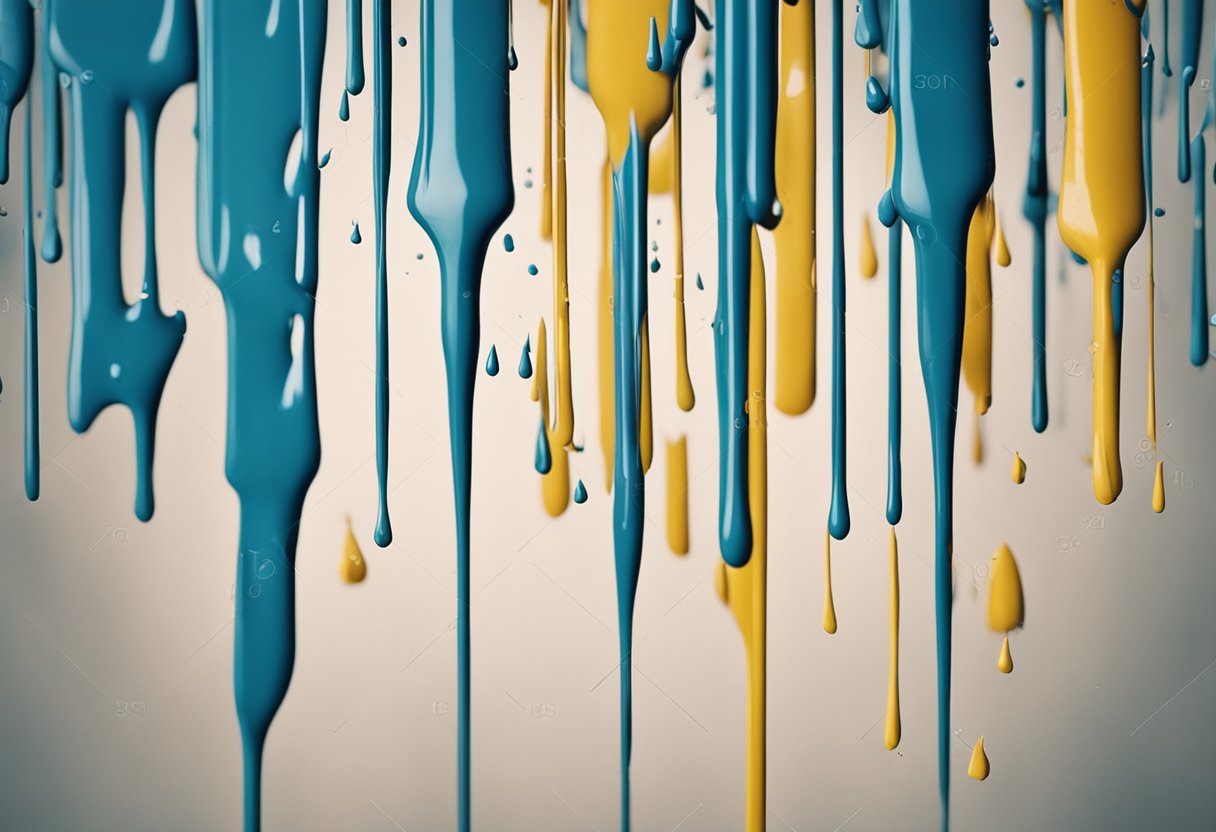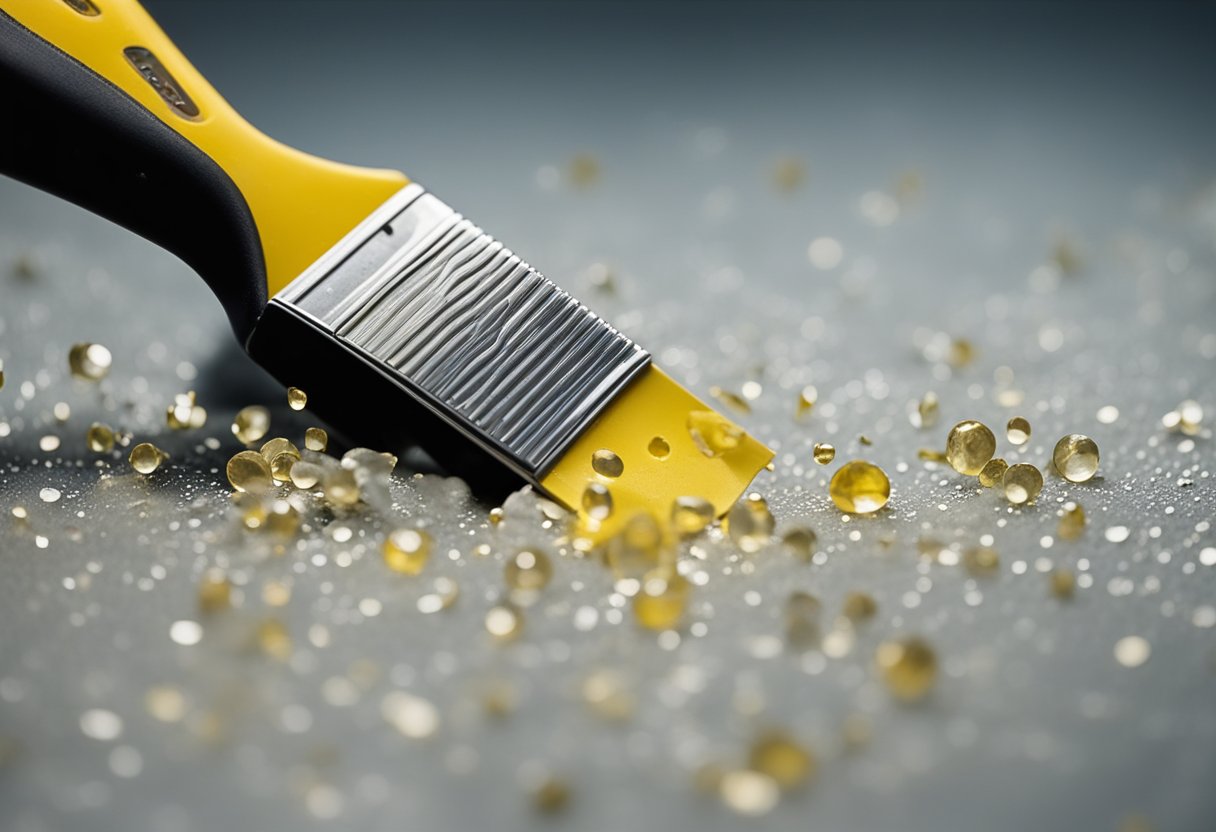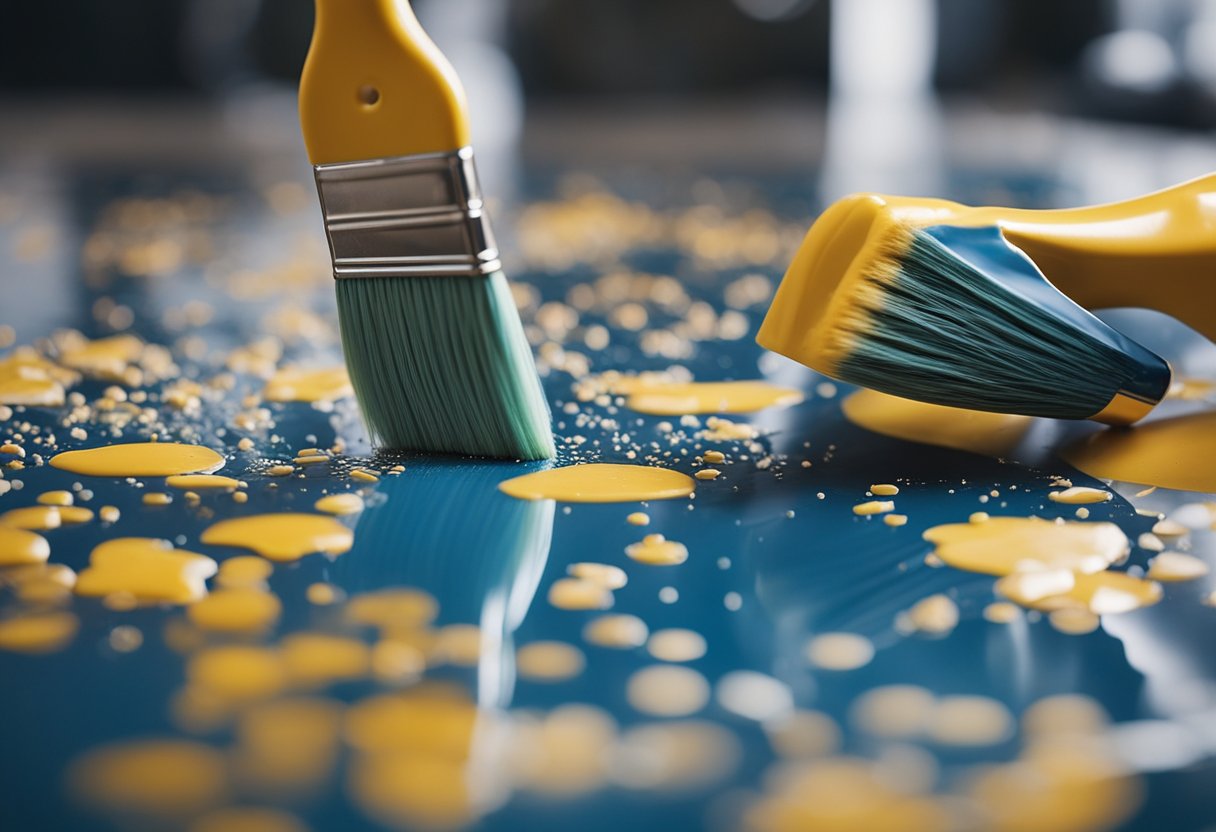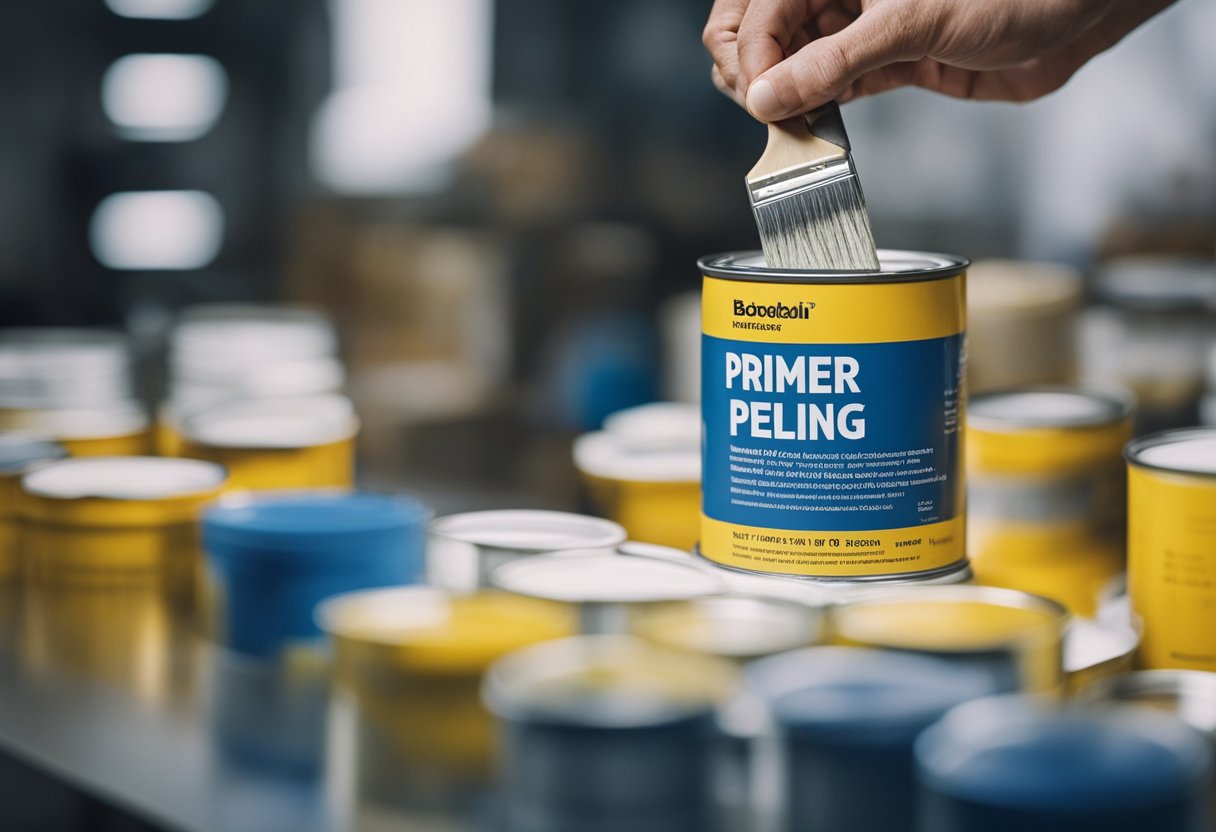I have been in situations where I have painted a surface, only to have the paint start peeling off after a few days. This can be frustrating, especially after investing time and effort into a painting project. One of the most common reasons for paint peeling off is poor adhesion between the paint and the primer. In this article, I will explore the reasons why paint may not be sticking to primer, and provide tips on how to fix this problem.
Understanding the basics of paint and primer is essential in identifying why paint may not be sticking to primer. Paint is a colored liquid that is used to coat surfaces for protection, decoration, and durability. On the other hand, primer is a preparatory coating that is applied to surfaces before painting. Its primary function is to create a smooth and even surface for the paint to adhere to. A good primer creates a bond between the surface and the paint, ensuring that the paint sticks to the surface and does not peel off.
Identifying the problem of why paint is not sticking to primer can be challenging, but there are several reasons why this may happen. Poor surface preparation, incompatible primer and paint, low-quality paint products, insufficient drying time, and environmental factors are some of the common causes of poor adhesion. In the next sections, I will explore these problems in detail and provide tips on how to fix them.
Key Takeaways
- Proper surface preparation is crucial for paint to stick to primer.
- Using incompatible primer and paint or low-quality paint products can cause poor adhesion.
- Environmental factors such as temperature and humidity can also affect the adhesion of paint to primer.
Understanding the Basics of Paint and Primer
https://www.youtube.com/watch?v=SO_o-cYWrPo&embed=true
As a professional painter, I understand the importance of using primer before painting. Primer is a preparatory coating that goes on surfaces before painting to improve paint adhesion. Primers “prime” or prepare the surface to accept paint.
There are different types of primers available on the market, including water-based primer, oil-based primer, and shellac-based primer. Each type has its own unique properties, and it is important to choose the right primer for the surface you are painting.
It is also important to consider the compatibility of the primer and paint you are using. For example, if you are using a water-based primer, you should use a water-based paint. Similarly, if you are using an oil-based primer, you should use an oil-based paint.
When it comes to paint not sticking to primer, there are several factors to consider. One of the major reasons for poor adhesion of paint to primer is poor surface preparation. Before priming your surface, proper surface preparation is very important. A dirty surface that is oily, greasy, and has imperfections will not take primer or paint properly.
Another factor that can affect paint adhesion is the type of paint being used. Latex paints are known to have poor adhesion to oil-based paint, so it is important to use the right type of primer and paint for the surface you are painting.
In summary, understanding the basics of paint and primer is crucial for achieving a smooth and long-lasting paint finish. Choosing the right type of primer and paint, ensuring proper surface preparation, and considering compatibility are all important factors to consider.
Identifying the Problem: Why Paint is Not Sticking to Primer
https://www.youtube.com/watch?v=xtsKsvGkIOw&embed=true
As a professional painter, I have encountered situations where the paint does not stick to the primer. This is a common issue that can be frustrating and time-consuming to fix. There are several reasons why paint may not stick to primer, and identifying the problem is the first step to solving it.
Poor Adhesion
One of the most common reasons for paint not sticking to primer is poor adhesion. This can occur when the surface is not properly prepared before priming. Any dirt, grease, or imperfections on the surface can prevent the primer from adhering properly, which in turn makes it difficult for the paint to stick. To ensure good adhesion, it is important to clean and prepare the surface thoroughly before applying primer.
Compatibility Issues
Another reason why paint may not stick to primer is compatibility issues. Not all paints and primers are compatible with each other, and using the wrong combination can result in a sticky finish. It is important to choose a primer that is compatible with the type of paint you are using. For example, oil-based primers may not work well with latex paint, and vice versa.
Poor Paint Adhesion
Poor paint adhesion can also be a reason why paint is not sticking to primer. This can occur when the paint is applied too thickly or when too much time has passed between the priming and painting stages. It is important to follow the manufacturer’s instructions when applying paint and to ensure that the primer is fully dry before painting.
In conclusion, identifying the problem is the first step to fixing paint that is not sticking to primer. Poor adhesion, compatibility issues, and poor paint adhesion are some of the most common reasons why this may occur. By properly preparing the surface, choosing compatible products, and following the manufacturer’s instructions, you can ensure that the paint sticks to the primer and provides a smooth and durable finish.
The Role of Surface Preparation
As someone who has been painting for years, I can confidently say that one of the most important steps in achieving a flawless-looking painted project is surface preparation. You might be tempted to skip this step, but trust me, it’s not worth it.
Before applying primer, you need to make sure the surface is clean and free of any grime, dirt, or old paint. If you’re working on a dirty surface, the primer won’t adhere properly, and the paint won’t stick to the primer. So, take some time to clean the surface thoroughly. You can use soap and water or a degreaser to remove any dirt or grime.
If you’re working on a surface with old paint, you need to remove it before applying primer. Old paint can prevent the primer from adhering properly, and the new paint won’t stick to the old paint. You can use a paint scraper or a chemical paint stripper to remove the old paint.
Once the surface is clean and free of old paint, you need to sand it to create a rough surface for the primer to adhere to. Sanding also helps to remove any stains, rust, imperfections, bumps, or pores on the surface. You can use sandpaper with a grit of 120 or higher to sand the surface.
After sanding, make sure to wipe the surface clean with a damp cloth to remove any dust or debris. Once the surface is dry and clean, you’re ready to apply the primer.
In summary, surface preparation is a crucial step in achieving a flawless-looking painted project. Make sure to clean the surface thoroughly, remove any old paint, and sand the surface to create a rough surface for the primer to adhere to. With proper surface preparation, the primer will adhere properly, and the paint will stick to the primer, resulting in a beautiful and long-lasting finish.
Impact of Environmental Conditions
https://www.youtube.com/watch?v=4JmairHhKD0&embed=true
Environmental conditions can have a significant impact on the adhesion of paint to primer. Temperature, weather, humidity, and moisture are all environmental factors that can affect the outcome of a paint job.
In cold weather, the paint may not stick to the primer properly due to the low temperature. Similarly, if the surface is too hot, the paint may dry too quickly, leading to poor adhesion. It is important to ensure that the temperature is within the recommended range before starting the painting process.
High humidity and wet surfaces can also cause the paint not to stick to the primer properly. In such cases, it is recommended to wait for the surface to dry completely before applying the paint. Additionally, high moisture levels in the air can affect the drying time of the paint, leading to poor adhesion.
To prevent these issues, it is important to consider the environmental conditions before starting the painting process. If the conditions are not suitable, it may be necessary to wait for better weather or to take steps to control the environment, such as using a dehumidifier.
In summary, environmental conditions play a crucial role in the adhesion of paint to primer. By understanding the impact of these factors, it is possible to achieve a flawless finish that will last for years to come.
Common Mistakes and How to Avoid Them
https://www.youtube.com/watch?v=HHgUoSHhO-M&embed=true
When it comes to painting, there are several common mistakes that can cause the paint not to stick to the primer. In this section, I’ll go over some of these mistakes and how to avoid them.
Heavy Application
One common mistake is applying too much paint or primer. This can cause the paint to not properly adhere to the surface, resulting in peeling or flaking. To avoid this, make sure to apply thin, even coats of paint or primer. This will ensure that the surface is properly covered without being overloaded with too much product.
Insufficient Drying Time
Another mistake is not allowing enough time for the primer to dry before applying the paint. If the primer is not fully dry, the paint may not properly adhere to the surface. To avoid this, make sure to follow the manufacturer’s recommended drying time for the primer before applying the paint.
Poorly Mixed Paint or Primer
If the paint or primer is not properly mixed, it may not properly adhere to the surface. To avoid this, make sure to thoroughly stir the paint or primer before use. This will ensure that the product is properly mixed and ready to use.
Thin Coats
Applying too thin of a coat of paint or primer can also cause adhesion issues. To avoid this, make sure to apply a sufficient amount of product to the surface. However, be careful not to overload the surface with too much product, as this can cause other issues.
Low-Quality Paint
Using a low-quality paint can also cause adhesion issues. Make sure to use a high-quality paint that is designed for the surface you are painting. This will ensure that the paint properly adheres to the surface and provides a long-lasting finish.
Spray Paint
If you are using spray paint, make sure to follow the manufacturer’s recommended instructions for use. This may include using a specific type of solvent or applying the paint in a specific manner. Failure to follow these instructions can cause adhesion issues.
Vinyl
If you are painting over vinyl, make sure to properly clean and prime the surface before painting. Vinyl can be difficult to paint, and failure to properly prepare the surface can cause adhesion issues.
By avoiding these common mistakes, you can ensure that the paint properly adheres to the primer and provides a long-lasting finish.
Best Practices for a Successful Painting Project
When it comes to painting projects, there are a few best practices that I always follow to ensure that the paint sticks to the primer and the final result looks great. Here are some tips that I would like to share:
Surface Preparation
One of the most important steps to ensure that the paint sticks to the primer is surface preparation. Before painting, I always make sure that the surface is clean, dry, and smooth. Any dirt, dust, or debris on the surface can prevent the paint from adhering to the primer. I use a TSP (trisodium phosphate) solution to clean the surface thoroughly and then rinse it with clean water.
Sanding
If the surface is glossy or has a rough texture, I always sand it before applying the primer. Sanding helps to create a rough surface that the primer can adhere to. It also helps to remove any loose paint, dirt, or debris that may be on the surface. I use a fine-grit sandpaper to sand the surface gently and then wipe it clean with a damp cloth.
Proper Drying Time
After applying the primer, it is important to allow it to dry completely before applying the paint. If the primer is not dry, the paint may not stick to it properly. I always follow the manufacturer’s instructions for the drying time of the primer and make sure that the surface is completely dry before applying the paint.
Thin Coats
When applying the paint, I always use thin coats instead of thick ones. Thick coats of paint can take longer to dry and may not stick to the primer properly. Thin coats of paint dry faster and adhere better to the primer. I apply the paint in multiple thin coats, allowing each coat to dry completely before applying the next one.
In conclusion, by following these best practices, I have been able to avoid the problem of paint not sticking to primer and achieve great results in my painting projects.
Troubleshooting and Fixing Poor Adhesion
https://www.youtube.com/watch?v=00JVUxABe44&embed=true
When paint doesn’t stick to the primer, it can be frustrating and time-consuming to fix. However, with a bit of troubleshooting, you can fix the problem and achieve a smooth, long-lasting finish.
First, it’s important to identify the cause of the poor adhesion. Some possible causes include poor surface preparation, primer and paint compatibility issues, using low-quality paint products, insufficient drying time, and environmental factors such as humidity or temperature.
To troubleshoot poor adhesion, start by examining the surface for any damage or imperfections. If there are any cracks, holes, or other damage, it’s important to repair them before applying primer and paint. Otherwise, the paint may pop or peel, leading to an uneven finish.
Next, make sure that the primer and paint are compatible. Using products that are not designed to work together can result in poor adhesion. Check the manufacturer’s recommendations to ensure that you are using the right products.
It’s also important to ensure that the surface is clean and dry before applying primer and paint. Any dirt, grease, or oil can prevent the paint from sticking properly. Use a degreaser or cleaner to remove any contaminants, and allow the surface to dry completely before applying primer and paint.
If you are still experiencing poor adhesion, consider using a heater or fan to speed up the drying process. This can help the paint adhere properly and prevent it from popping or peeling.
In summary, troubleshooting poor adhesion requires careful examination of the surface, ensuring compatibility between primer and paint, proper surface preparation, and sufficient drying time. By following these steps, you can achieve a smooth, long-lasting finish that will stand the test of time.
Frequently Asked Questions
How to fix patches of paint that won’t stick?
If you have patches of paint that won’t stick, it could be due to a number of reasons. One common reason is that the surface was not properly cleaned or prepared before painting. To fix this issue, you can sand the area lightly to remove any loose or peeling paint, clean the surface thoroughly, and then apply a new coat of paint.
Why isn’t my paint sticking to the primer?
If your paint is not sticking to the primer, it could be due to a few reasons. One reason could be that the primer was not allowed to dry completely before painting over it. Another reason could be that the type of paint you are using is not compatible with the primer. To fix this issue, you can sand the surface lightly, clean it thoroughly, and then apply a new coat of primer followed by a new coat of paint.
How do you fix paint that didn’t stick?
If your paint did not stick properly, you can fix it by sanding the surface lightly to remove any loose or peeling paint, cleaning the surface thoroughly, and then applying a new coat of paint. It is important to ensure that the surface is completely dry before applying the new coat of paint.
Why is primer peeling off?
If your primer is peeling off, it could be due to a few reasons. One reason could be that the surface was not properly cleaned or prepared before applying the primer. Another reason could be that the surface was too smooth or glossy, which prevented the primer from adhering properly. To fix this issue, you can sand the surface lightly, clean it thoroughly, and then apply a new coat of primer.
Why is paint not sticking to my furniture?
If your paint is not sticking to your furniture, it could be due to a few reasons. One reason could be that the surface was not properly cleaned or prepared before painting. Another reason could be that the type of paint you are using is not compatible with the surface material. To fix this issue, you can sand the surface lightly, clean it thoroughly, and then apply a new coat of paint that is specifically designed for use on furniture.
How to ensure paint sticks to plaster wall?
To ensure that paint sticks to a plaster wall, it is important to properly prepare the surface before painting. This includes filling in any cracks or holes with spackling compound, sanding the surface lightly to create a rough texture, and cleaning the surface thoroughly. Once the surface is properly prepared, you can apply a coat of primer followed by a coat of paint that is specifically designed for use on plaster surfaces.

Hi, I’m Sal Muller of Tooltrip.com. My DIY experience led me to understand essential power tools for home projects. Tooltrip.com guides enthusiasts and professionals in choosing right tools for any job. I provide concise top tool reviews for easier, efficient DIY.





